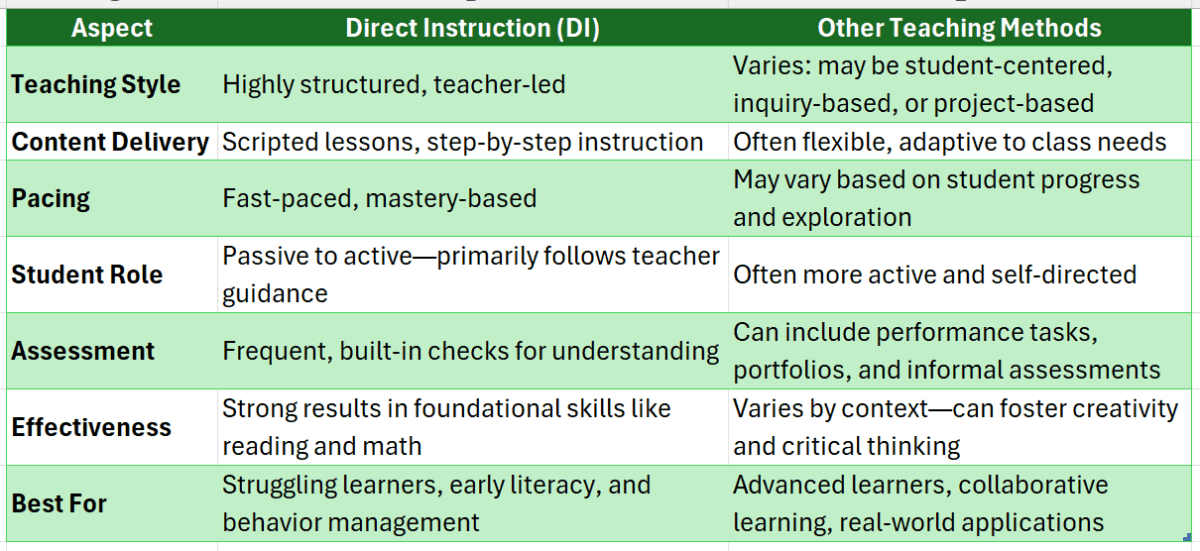
Direct Instruction Education (DIE) has become a hot topic among educators and parents. Understanding its effectiveness is crucial for enhancing student learning experiences. So, is DIE the key to improving student outcomes? Let’s explore!
What is Direct Instruction Education?
Direct Instruction Education is a structured teaching method that emphasizes clear, explicit instructions. It focuses on teaching specific skills in a sequenced manner, similar to following a recipe to ensure students understand essential concepts.
Key Features of Direct Instruction Education
- Clear Objectives: Each lesson has specific goals.
- Active Participation: Students engage actively, making learning interactive.
- Immediate Feedback: Teachers provide quick responses to help students improve.
- Phonics Teaching: This method often includes phonics teaching, vital for reading skills.
Benefits of Direct Instruction Education
- Improved Student Outcomes: Research indicates that students often perform better academically.
- Community-Based Instruction: It can adapt to include community-based instruction, making learning relevant.
- Structured Learning Environment: Students thrive in a predictable and organized setting.
In conclusion, Direct Instruction Education provides a systematic approach that can enhance student learning and boost academic success. Could this be the solution for better educational outcomes?
Study smarter, not harder—Enroll online today!
How Does Direct Instruction Education Compare to Other Teaching Methods?

When we talk about effective teaching methods, Direct Instruction Education often comes up. This structured approach focuses on clear, explicit teaching, aiming to boost student outcomes. But how does it stack up against other methods like Community-based instruction or Phonics teaching? Let’s explore!
Direct Instruction vs. Other Methods
Direct Instruction Education is all about clarity and structure. Unlike Community-based instruction, which emphasizes learning through real-world experiences, Direct Instruction focuses on direct teaching of skills. This can lead to faster mastery of subjects, especially in foundational areas like reading and math.
Key Comparisons
- Direct Instruction Education: Structured, teacher-led, effective for skill mastery.
- Community-based Instruction: Focuses on real-life applications, promoting social skills and independence.
- Phonics Teaching: A method often used within Direct Instruction to enhance reading skills through sound-letter relationships.
In summary, while each method has its strengths, Direct Instruction Education shines in delivering clear, measurable outcomes for students.
The Science Behind Direct Instruction: What Research Says
Direct instruction education has sparked a lot of debate among educators and parents alike. Understanding its effectiveness is crucial because it directly impacts student outcomes. With so many teaching methods available, knowing which ones truly help students learn can make all the difference in their academic journey.
Proven Effectiveness
Research shows that direct instruction can significantly improve student learning. Studies indicate that structured lessons lead to better retention of information. This method emphasizes clear objectives and immediate feedback, making it easier for students to grasp complex concepts.
Key Benefits of Direct Instruction Education
- Structured Learning: Direct instruction provides a clear framework for lessons, helping students stay focused.
- Immediate Feedback: Teachers can quickly address misunderstandings, enhancing learning.
- Community-Based Instruction: This approach can be integrated with community-based instruction, allowing students to apply their skills in real-world settings.
- Phonics Teaching: Direct instruction is particularly effective in phonics teaching, aiding early readers in developing essential skills.
In summary, the research supports the effectiveness of direct instruction education, especially when combined with other methods like community-based instruction and phonics teaching.
Are Student Outcomes Improved with Direct Instruction Education?
Direct Instruction Education has sparked a lot of discussions among educators and parents alike. The big question is: does it really improve student outcomes? Understanding this can help us make better choices for our kids’ learning paths. Let’s dive into the effectiveness of this teaching method.
What is Direct Instruction Education?
Direct Instruction Education focuses on structured lessons and clear instructions. Teachers guide students step-by-step, ensuring they grasp each concept before moving on. This method contrasts with other approaches, like community-based instruction, which may allow for more exploration but can sometimes leave gaps in understanding.
Benefits of Direct Instruction
- Clear Expectations: Students know exactly what is expected of them.
- Immediate Feedback: Teachers can quickly address misunderstandings.
- Phonics Teaching: This method often includes phonics teaching, which is crucial for reading success.
Many studies suggest that students taught through Direct Instruction show improved test scores and better retention of information. So, if you’re wondering whether this approach is effective, the evidence leans towards a resounding yes!
Key Components of Effective Direct Instruction Programs
Direct instruction education is a teaching method that focuses on structured lessons and clear objectives. Understanding its effectiveness is crucial because it can significantly impact student outcomes. By exploring the key components of effective direct instruction programs, we can see how they help students learn better and achieve their goals.
- Clear Objectives: Each lesson starts with specific goals, so students know what they are expected to learn. This clarity helps them focus and stay engaged.
- Modeling and Practice: Teachers demonstrate skills before students practice them. For example, in phonics teaching, a teacher might show how to sound out words, allowing students to replicate the process.
- Immediate Feedback: Students receive quick responses to their answers, which helps them correct mistakes right away.
This is especially important in community-based instruction, where real-world applications are emphasized. Incorporating these components into direct instruction education can lead to improved student outcomes. By ensuring lessons are structured and interactive, educators can create a supportive learning environment that fosters success. Ultimately, when students understand what they are learning and why, they are more likely to thrive.
Challenges and Criticisms of Direct Instruction Education
Direct Instruction Education has sparked a lot of debate among educators and parents alike. Understanding its effectiveness for student outcomes is crucial, especially as schools strive to improve learning. While many praise its structured approach, others raise concerns about its limitations. Let’s explore the challenges and criticisms surrounding this method.
Limitations of Direct Instruction Education
One major criticism is that Direct Instruction can be too rigid. Students often thrive in environments that allow for creativity and exploration. When teaching is overly structured, it may not cater to diverse learning styles. This can lead to disengagement, especially for students who benefit from more interactive methods like community-based instruction.
The Role of Phonics Teaching
Additionally, while phonics teaching is a key component of Direct Instruction, some argue that it doesn’t address comprehension skills adequately. Students might learn to decode words but struggle to understand their meaning. Balancing phonics with comprehension strategies is essential for holistic learning. Ultimately, while Direct Instruction has its merits, it’s important to consider these challenges to ensure all students succeed.
Study smarter, not harder—Enroll online today!
Real-World Applications: Success Stories from Direct Instruction Classrooms
Direct instruction education has gained attention for its structured approach to teaching. But how effective is it for student outcomes? This method emphasizes clear, direct teaching techniques, which can lead to impressive results. Let’s explore some real-world applications and success stories that highlight its impact.
Success Stories in Direct Instruction Classrooms
Many schools have adopted direct instruction education with remarkable outcomes. For instance, a school in Texas implemented this method and saw a 30% increase in reading scores. Students thrived in a structured environment, benefiting from phonics teaching that built their foundational skills.
Community-Based Instruction
Another success story comes from a community-based instruction program. Here, students with special needs received tailored direct instruction. The results were astounding! Students not only improved academically but also gained confidence and social skills, showcasing the versatility of this teaching method. In summary, direct instruction education can lead to significant improvements in student outcomes. By focusing on clear teaching methods and community involvement, schools can create environments where all students succeed. These success stories prove that with the right approach, every student can shine.
How Can Scholarship.Education Support Your Direct Instruction Journey?
Direct instruction education is gaining attention in classrooms, with many educators questioning its effectiveness in improving student outcomes. This structured approach, featuring clear steps and focused teaching methods, helps students understand complex concepts more easily. So, how can you maximize its benefits?
Tailored Resources
At Scholarship.Education, we offer tailored resources that align with direct instruction education, particularly in phonics teaching. Our materials help students build a strong reading foundation and progress at their own pace.
Community-Based Instruction
We emphasize community-based instruction, connecting classroom learning to real-world experiences. This integration makes lessons relatable, enhancing students’ understanding and retention.
Engaging Activities
Our platform features engaging activities that reinforce direct instruction. These fun, interactive tasks keep students motivated while they learn essential skills through phonics games and challenges.
Professional Development
We provide professional development for educators, offering workshops on effective direct instruction strategies. This ensures teachers are confident and well-equipped to improve student outcomes.
Ongoing Support
Finally, Scholarship.Education offers ongoing support, providing lesson plans and tips for community-based instruction. With the right tools and guidance, every student can succeed.
Future Trends in Direct Instruction Education: What to Expect
Direct instruction education has been a hot topic in classrooms across the globe. As educators seek effective methods to boost student outcomes, understanding the future trends in this teaching approach becomes essential. Will it continue to evolve, or will new methods take its place? Let’s explore what lies ahead!
Emphasis on Community-Based Instruction
One exciting trend is the integration of community-based instruction. This approach connects classroom learning with real-world experiences. Students can apply their skills in local settings, making learning more relevant and engaging. Imagine practicing math while helping at a community garden!
The Rise of Phonics Teaching
Phonics teaching is also gaining traction within direct instruction education. As research shows its effectiveness in reading, more schools are adopting structured phonics programs. This method helps students decode words, improving their reading skills significantly. It’s a game-changer for young learners! In conclusion, the future of direct instruction education looks promising. With a focus on community connections and effective phonics teaching, educators are poised to enhance student outcomes. As these trends unfold, we can expect more engaging and impactful learning experiences for students everywhere.
Study smarter, not harder—Enroll online today!
FAQs
1. What is Direct Instruction in education?
Direct Instruction (DI) is a structured, teacher-led method of instruction that uses scripted lessons, clear objectives, and step-by-step teaching to ensure all students learn effectively.
2. How is Direct Instruction different from traditional teaching?
Unlike traditional teaching, DI emphasizes explicit teaching, immediate feedback, frequent assessment, and minimal student-led exploration.
3. What are the key features of Direct Instruction?
Key features include scripted lessons, fast-paced teaching, group responses, regular review, and mastery-based progression.
4. What subjects work best with Direct Instruction?
It’s especially effective in foundational subjects like reading, math, and language skills, particularly in early education or with struggling learners.
5. Is Direct Instruction backed by research?
Yes, decades of research show that DI can significantly improve student outcomes, especially for at-risk and low-performing students.
6. Does Direct Instruction limit creativity in the classroom?
Some critics say it does, but supporters argue it builds core skills quickly so students can apply them creatively later on.





